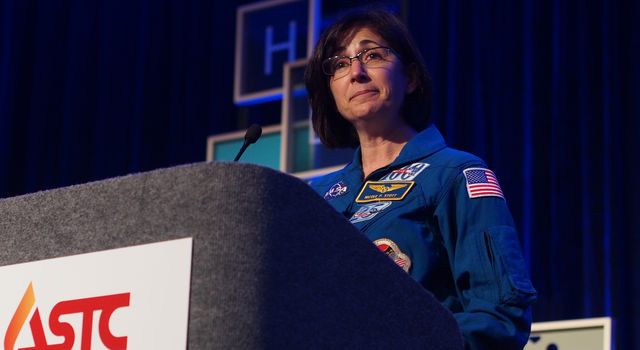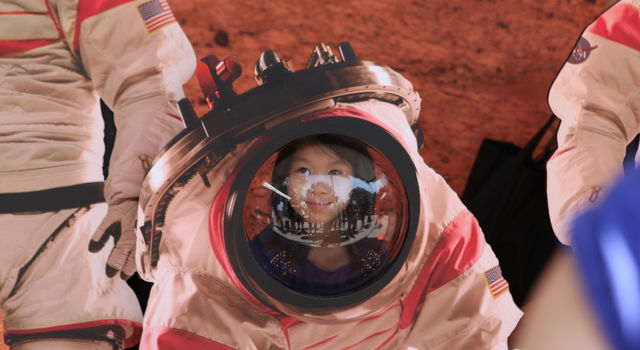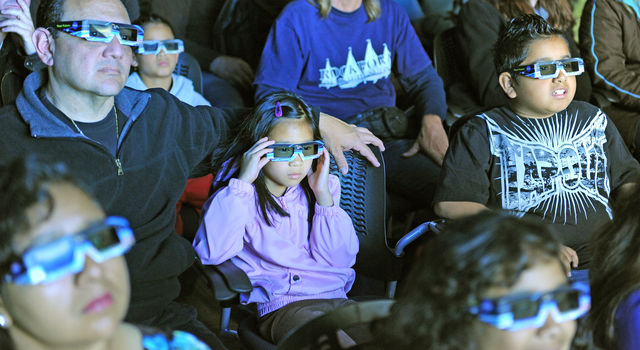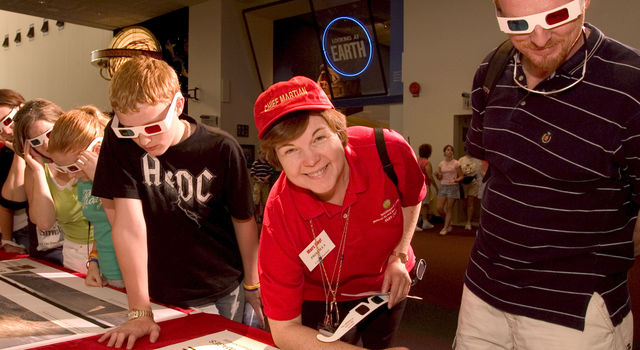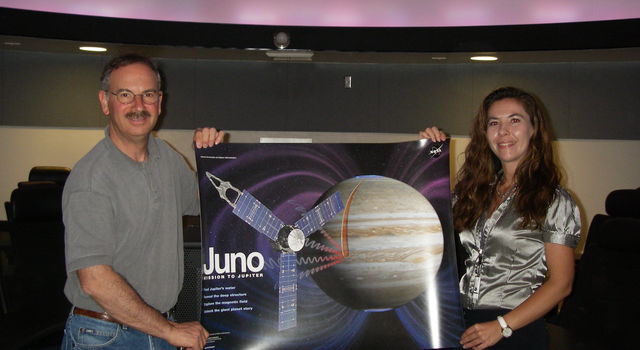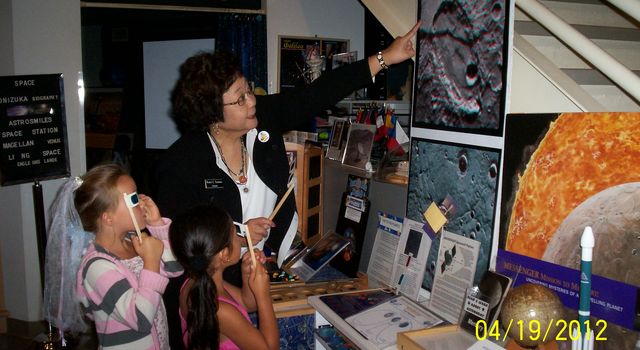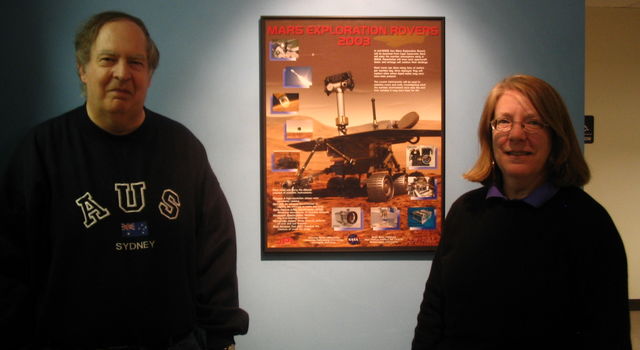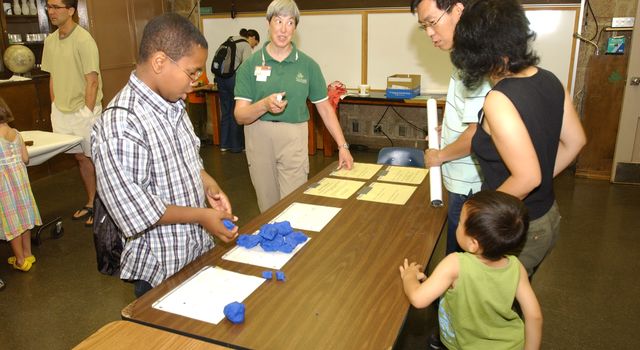Museum Alliance | October 5, 2016
NASA on Parade at Annual Science Center Conference
Where do museums shop for animatronic dinosaurs? Test out different planetarium formats? Get the latest news on exhibits to rent? The Association of Science-Technology Centers Annual Conference is one place! NASA’s Museum Alliance was there to spread the word about the Alliance and all the NASA resources available to science centers, as well as to check in with institutions already featuring NASA content. Here are a few highlights:
NASA’s Journey to Mars and Universe of Learning booths were hot spots. Institutes interested in presenting the future of human space exploration, answering big questions about how our universe works, or taking a virtual tour via Eyes on Exoplanets kept the staff busy.
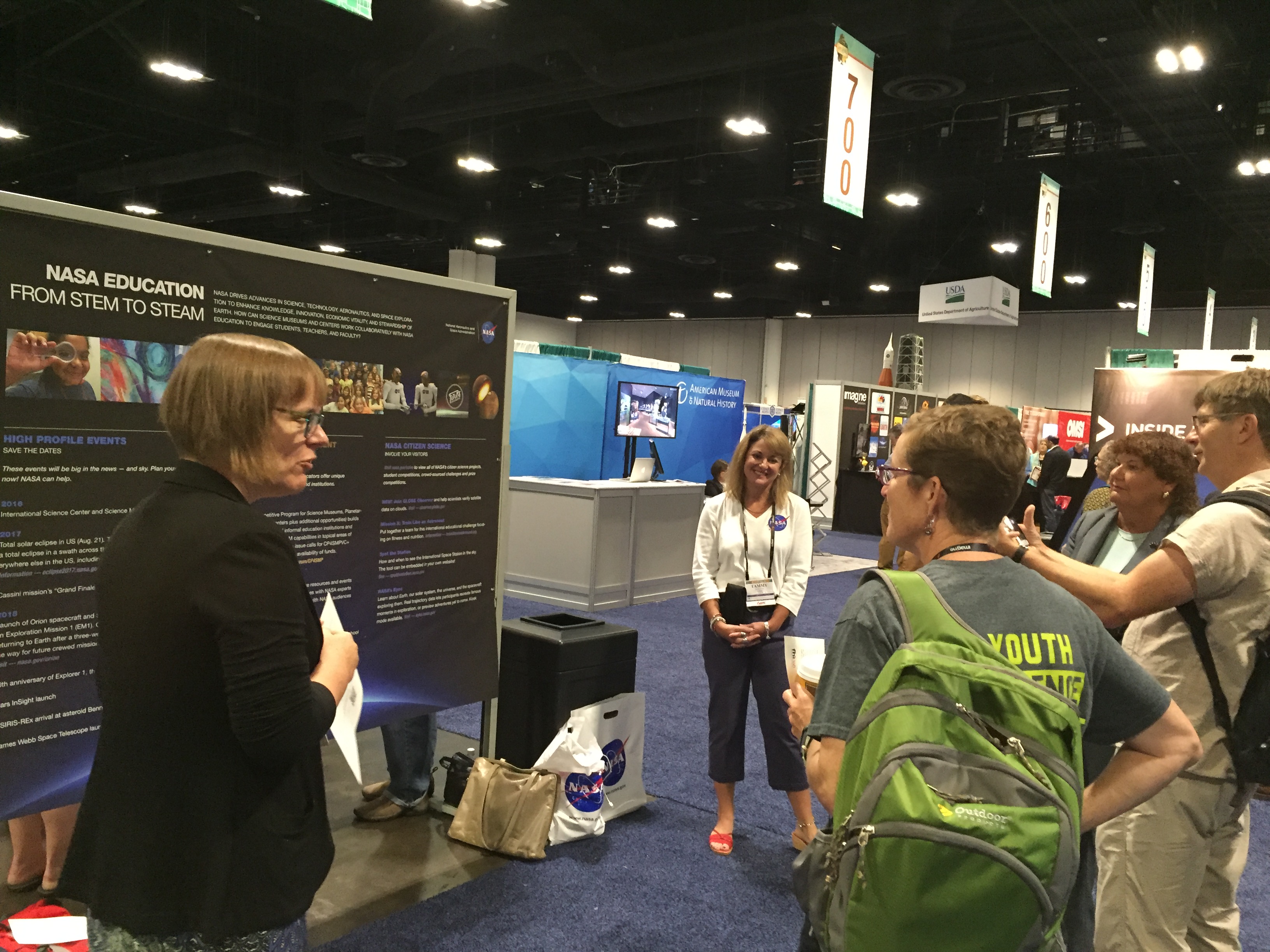
Attendees learned how they could get involved with various NASA programs designed for museums and science centers.
Museums were excited to sign up for the new GLOBE Observer citizen science app and get their guests involved in collecting real Earth data. (But you don’t have to be with a museum to use the app or these resources!)
At the Live Demonstration Hour, actor Douglas Coler performed a play about the Gemini 4 spacewalk, which recently earned playwright Chris Bresky from the Adler Planetarium an award from the International Museum Theater Alliance.
Also at the demo hour, the Orlando Science Center’s Stephanie Kazmierzak and her four brave volunteers wowed the crowd with this engineering demonstration/party trick.
The agency’s Competitive Program for Science Museums, Planetariums, and NASA Visitor Centers provides funding in support of NASA-related content. (Check out the Map of Awardees to see what NASA content might be in a museum near you.) Many of the grantees attended the conference and shared project updates.
The Children’s Museum of Indianapolis, for instance, just opened its International Space Station exhibit, Beyond Spaceship Earth, and lets visitors see what its like to be an astronaut. Can’t make it to the museum? There’s an app for that!
The Discover NASA exhibit for libraries has been reaching about 20,000 people at each site it visits, with hosts putting on all kinds of related special programming. Check out the schedule to see if it’s coming to a library near you.
Another awardee, GirlStart, provides students with STEM learning via after school classes, festivals and summer camps. Its DeSTEMber celebration is available for anyone, anytime. The daily hands-on activities are designed for families to do at home, together.
With more than 600 members in nearly 50 countries, the Association of Science-Technology Centers has quite a lot going on. Luckily, there’s an online search tool so you can find out what’s happening at a member center near you! Maybe you can even see what dinosaur they ended up picking out.
At a museum, science center, library, camp or other informal education institution? Learn how you can join the more than 700 organizations participating in NASA’s Museum Alliance, here.
TAGS: Association of Science-Technology Centers, Conference, Museums, Science Centers, Museum Alliance, CP4SMP
Museum Alliance | July 13, 2016
Discover NASA at Summer Camp
Our last blog highlighted some of the great STEM exhibits and events members of NASA’s Museum Alliance have going on – and how summer is a perfect time to check them out! In fact, for school-aged children, spending the summer learning new things, building new skills, and staying active is also of academic benefit.
July 14 is National Summer Learning Day. As first lady Michelle Obama points out in her message below, taking a break from learning over the summer puts kids at a significant disadvantage when they go back to school.
Luckily, the museums, libraries, observatories and parks of NASA’s Museum Alliance offer an incredible range of summer learning opportunities for students!
Summer camps let kids dig into a theme – they can spend a week being Mars explorers, roboticists, inventors, even "Junior Rebels" investigating the explosions, lasers, holograms and intergalactic space travel of Star Wars. One-day camps, overnight opportunities, camps for pre-schoolers and their adults, teen camps, and chances to mentor younger campers – there’s something for all ages and interests. Summer also brings special festivals, increased drop-in opportunities at maker spaces, and the chance to use the break from “school night” bedtimes to join a star party.
Use the Museum Alliance Events Near Me resource to see what our members have going on this summer, or check out the sortable list of organizations to see which are near you.
TAGS: summer camp, summer learning day, learning gap, museum alliance, museums, planetariums
Museum Alliance | February 26, 2016
NASA Museum Partners to Offer Free Admission on March 12
On March 12, the Smithsonian Institution will sponsor a special edition of Museum Day Live, an annual nationwide event designed to get people into their local museums, science centers and other cultural institutions. Taking place during Women’s History Month, the event is meant for all visitors but is specially themed toward inspiring the nation’s girls. Participating institutions will offer free admission for the day.
NASA plans to have strong participation through its Museum Alliance, a community of not just museums, but also planetariums, science centers, libraries, parks, observatories and other youth-serving STEM organizations.
For a list of the more than 350 participating institutions and to get your free tickets, visit the event website.
To learn more about getting your museum involved, contact Amelia.J.Chapman@jpl.nasa.gov.
Also, check out these tips for Engaging Girls in STEM, including ways the public can connect with NASA!
Museum Alliance | February 25, 2016
What's the Museum Alliance?
Quick! What do you think when you hear “Education”?
If you’re like many people, you thought “School.” But of course people are always learning, no matter their age and regardless of whether they’re being graded. All that out-of-school, life-long learning is the reason for the term “informal education.”
Since 2002, JPL’s Informal Education group has run NASA’s Museum Alliance, providing museums and other informal education institutions with access to NASA staff, resources and professional development.
More than 700 organizations around the world – not just museums, but also planetariums, science centers, libraries, parks, observatories, camps, nature centers, and youth-serving organizations – are Museum Alliance members. They in turn share those NASA resources with their own audiences, through exhibitions and programming.
Last summer’s historic flyby of Pluto illustrates the impact of this approach. Museum Alliance members were kept up to date on the mission and image-release timeline, received New Horizons giveaways for their visitors, were able to speak directly with mission scientists, received training on related hands-on activities, and were given all the latest links, social media resources and downloadable graphics.
Numerically, these Museum Alliance organizations put on almost 2,000 Pluto-focused events in 36 states and eight countries. But more important, they were able to use this teachable moment to serve their audiences – diverse audiences who came with a broad range of experiences and interests.
They helped people learn when no one “had to” learn anything – and not just about Pluto. Every day, Museum Alliance members build on the intrinsically inspiring work of NASA in order to encourage people’s natural drive to know more, a drive that is itself at the heart of NASA’s mission.
> Visit the Museum Alliance website to learn more about the program and its members.
Edu News | May 23, 2012
Museum Alliance Lands More Than 500 Partners
It was 2003, just a year before NASA's Mars rovers, Spirit and Opportunity, were set to land on the Red Planet in a feat of engineering ingenuity rarely seen on the third planet from the sun - let alone the fourth -- and there was a problem on the horizon. Museums, planetariums and science centers, the very organizations that would inevitably become local experts for the much-anticipated landings, were severely lacking access to NASA's resources.
"A year before the landings, we started a conversation with about 12 museums and planetariums around the country," said Anita Sohus, who now leads the brainchild of that conversation, the Museum Alliance, at NASA's Jet Propulsion Laboratory in Pasadena, Calif. "We talked about what kinds of resources they would like and by the end of November 2003 we had 130 organizations sign up [for the Museum Alliance] immediately."
When the landings rolled around, many of the Museum Alliance partners, who had been given unique access to mission personnel as well as visualizations and materials, held their doors open through the night -- some in blizzard conditions -- and still had overflow crowds to witness the landings. "It was clear we were on to something big," said Sohus.
Nine years later on a Thursday afternoon, 65 people log in to one of the Museum Alliance's teleconferences. Susana E. Deustua, an associate scientist on the Instruments Division team at the Space Telescope Science Institute is describing how NASA's Hubble Space Telescope will use the moon as a mirror to observe the upcoming transit of Venus, an event that won't take place again for another 105 years. The telecon inspires a string of questions and curiosities, which will later be shared with the thousands of visitors, students, teachers and life-long learners who visit one of the more than 500 organizations currently participating in the Museum Alliance.
Today, the Museum Alliance continues to play an important and essential role, connecting its partners with the missions and resources they need most and turning those connections into new ways to engage the public. A quick look at the Museum Alliance website, where partners list hundreds of NASA-related events at their various centers, speaks not only to the Alliance's incredible reach, but also the value it provides.
"When we're able to talk to [the scientists doing research on these missions] directly, it makes a big difference in terms of sharing that information with our audience. It's priceless," said Shawn Laatsch, a planetarium manager at the 'Imiloa Astronomy Center of Hawaii who joined the Museum Alliance in 2003 when he was managing a planetarium in Kentucky. "Every planetarium show we do has a live segment, so when there are new discoveries, we try to incorporate them into the show."
For Greg Andrews, the astronomy program leader at Sci-Port Louisiana's Science Center, who says his background in physics hadn't prepared him for the spotlight of public presentations, the telecons are a lesson in translation. "Not everybody thinks the way I do," he said. "The telecons have a great way of breaking down the information so you can understand it and relay it to others."
In addition to the telecons, which cover topics as diverse as distant star formation and NASA's newest visualization programs and bring in dozens of participants each session, the Museum Alliance provides organizations with unique resources and materials that alone can encourage thousands of visits.
"The Museum Alliance is a good place for resources," said Mal Cameron, an education specialist at the Christa McAuliffe Planetarium in Concord, N.H., which in 2005 was one of only two places in New England with large-scale images from the Hubble Space Telescope on display - a mural donated by the Space Telescope Science Institute. "It's been great for getting people to come see us. We're always looking for ways we can advance what we do as a science center."
David Falk, a full-time instructor of astronomy and the planetarium director at Los Angeles Valley College, says the resources offered by the Museum Alliance, which over the years have included educational posters and instructional DVDs, bring in visitors to the planetarium and students to the college's science programs. "We're always trying to get people to attend Los Angeles Valley College, and the Museum Alliance has become a big part of that," he said. "Getting pictures from the Mars missions and others is like gold."
And this constant stream of resources and connections is turning Museum Alliance partners into experts in their own right, who can then use their insights to engage and inspire others.
"I love those teaching moments when kids come up to you with questions to answer and a lot of it I know" said Cameron. "Much of what I've learned is from the Museum Alliance."
With more exciting mission events and discoveries always just around the corner, the future looks bright for the Museum Alliance as it launches into its second decade. "We add value because we give members a direct pipeline to information from NASA and insight directly from mission experts," said Sohus.
To learn more about the Museum Alliance and how museum professionals can get involved, visit http://informal.jpl.nasa.gov/museum/index.cfm.
Visit http://informal.jpl.nasa.gov/museum/Visiting to find a listing of Museum Alliance organizations near you.
TAGS: Museum Alliance, Programs, Informal Education,




